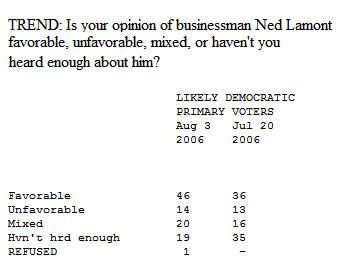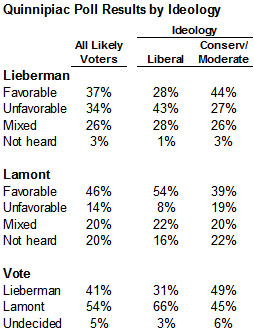By now it seems that the entire political blogosphere has taken note of the latest Quinnipiac poll of Connecticut primary voters showing Net Lamont leading Joe Lieberman by 13 points (54% to 41%). Much of the commentary I have seen has been appropriately cautious. As noted here previously, polling in this sort of primary is difficult and results may vary widely depending on the way the pollster samples and identifies “likely voters.” If it’s not too late, I want to point out a few things about the Quinnipiac poll that — caveats aside — bode well for Ned Lamont.
If nothing else, Quinnipiac has been consistent in their methodology, while caution is in order regarding the current levels of candidate support, the tracking polls provide an excellent gauge of the trends in that support. And the trend of late is clearly all in Lamont: He has gone from trailing Lieberman by 15 points in June (40% to 55%), to 4 point lead two weeks ago (51% to 47%), to the 13 point (54% to 41%) lead on the current survey.
The aside from the overall numbers, two things stand out for me that have generally not been given much notice elsewhere:
First, Lamont’s favorable rating has increased even more in the last two weeks than his share of the vote. It jumped ten points, from 36% to 46%, while his unfavorable rating remains quite low at 14% (up just one point from 13%):

This is a remarkable trend given the conventional wisdom that “Lamont has built his lead almost entirely on dissatisfaction with Lieberman,” as the Washington Post’s Dan Balz put it this morning. It is certainly true that on another question, 44% of Lamont’s supporters say that “Lieberman’s support for the war in Iraq” is their “main reason” for their choice. But Lamont has clearly made a positive impression in his own right. Consider also the negative advertising run by the Lieberman campaign, arguing among other things, that Lamont has put forward little more than a “No Joe” slogan. Despite the negative ads and Lieberman’s aggressive debate performance, Lamont’s unfavorable rating remains at just 13%, while his favorable rating (46%) is now nine points higher than Lieberman’s (37%).
The second notable finding is the surprising collapse of Lieberman’s support among moderate to conservative Democrats. Among liberals, Lamont is currently trouncing Lieberman by a more than two-to-one margin (66% to 31%). But as my friend Charles Franklin points out, Lieberman’s support has also dropped sharply among moderate to conservative Democrats, falling from 61% in June to just 49% on this latest survey. Lieberman’s lead among moderate and conservative Democrats has fallen from 35 points in June to a statistically insignificant 4 points (49% to 45%).

Consider that finding in light of what Chris Barnes, associate director of the Center for Survey Research and Analysis at the University of Connecticut, had to say about primary polls in his state. According to Hartford Courant columnist, Barnes believes that Connecticut primary polls “exaggerate the number of moderate Democrats who will vote and understates the liberal turnout.”
Perhaps. While the Quinnipiac poll release does not tell us the precise liberal percentage of their sample, their cross-tabulations imply that it is somewhere in the mid 40s, probably about 44%. The exit polls** conducted for recent Democratic presidential primaries in Connecticut indicate a more liberal electorate: 56% in 2004 and 46% in 2000. Turnout for those primaries was not high — 130K (or 19% of registered Democrats) in 2004 and 177K (or 26%) in 2000. Keep in mind, however, that these results may differ depending on the way pollsters ask the ideology question.
However, given the state of the race as measured by Quinnipiac, the size of the liberal electorate may not affect the outcome. Lamont’s lead will be much wider, of course, if the Quinnipiac poll is under-sampling liberals. However, Quinnipiac now has the race so close among moderate and conservative Democrats that (by my own calculations) Lamont still leads by eight points even if we assume that liberals make up only 30% of the primary electorate. In fact, given the Quinnipiac results, the race would still be a 47-47% tie even if we assume liberals make up only 10% of the electorate!
Again, caution is always in order when it comes to polls for this sort of primary. The turnout puzzle should make us all skeptical of any poll on this race. Other polls that have been conducted this week by the campaigns or other pollsters may yield different results. But consider the news Dan Balz managed to extract from one member of the Lieberman campaign:
Another campaign adviser, who spoke on the condition of anonymity in order to discuss strategy, said the public poll tracked internal campaign surveys. “The race has been headed in that direction for a while,” the adviser said. “It’s a fairly accurate reflection of where the race is.”
If so, things are looking very promising for Ned Lamont.
**My source for the past exit poll results are the codebooks available for download through the Inter-University Consortium for Political and Social Research (ICPSR).
UPDATE – Tim Tagaris on the official Ned Lamont blog has this to say about their campaign’s internal polling: “I can tell you one thing, our numbers don’t show us up 13 – and that is no spin.”
UPDATE II – In a comment below, DemfromCt passes on word of another poll of likely Democratic primary voters in Connecticut, this one conducted for Theday.com by Research2000 that has Lamont ahead of Lieberman by 10 points (53% to 43%).
UPDATE III (8/5) – More details this morning in The Day on the /Research 2000 poll. They conducted 600 interviews of likely Democratic primary voters using random digit dial (RDD) sampling. The article includes no further information on how likely voters were selected or how many adults were interviewed in order to select the 600 likely voters.
If moderately liberal Senators are going down to 10+ point defeats because they’re too conservative, just imagine what’s going to happen to the Republicans. There is a sea-change going on in American politics. November is going to be an absolute rout. 2006 will go down as the watershed year for the progressive revolution in the United States. Right now, there’s a very good chance that we’re witnessing the final few months of Republican control in our lifetimes.
It’s hard for me to take Tagaris’ comments seriously when the Washington Post reported the following today:
“Facing a likely defeat, Lieberman has scrapped plans for a massive and costly get-out-the-vote operation on primary day, according to several Democratic sources. Instead, he will shift some of his resources into more television commercials designed to highlight his accomplishments for the state, in hopes of boosting his battered image.”
Sounds like Lieberman is all but conceding defeat.
Except that people on the ground in CT say otherwise. Doesn’t look like Joe is giving up. it looks like he’s setting the bar higher so he can call a loss a win. hedging his bets.
See also this local poll:
Senate challenger Ned Lamont holds a 10-point lead over Sen. Joe Lieberman, according to a new poll commissioned by The Day.
Lamont, a Greenwich businessman, would take 53 percent of the primary vote compared to 43 percent for Lieberman, a three-term incumbent whose campaign for reelection has been hampered by his support for the war in Iraq, and criticism from some Democrats that he has been too close to Republicans and President George W. Bush.
I love Tagaris but of course he’s spinning.
And he is right to do so.
Shoulder to the wheel.
Thought I’d share this here as another example to follow Jane “Hitler Youth” Hamsher’s racist photoshop moment:
In response to the reports of the racism of Round Hill Country Club, Ned Lamont claimed that the club was NOT discriminatory, despite the fact that the staff dormitory located on club grounds was referred to by members as “the monkey house”, a racist reference to the club’s staff. Did Lamont just ignore that? Perhaps he felt it was part of Round Hill’s “charm” as perhaps Barbara Bush would have phrased it.. as she and George H. W. Bush also belonged to the club.
The source is the written facts by an African American lawyer who decided to go under cover in the Round Hill Country club as a waiter, and documented the racism and discriminatory tactics of the membership. Here is a url to a citing of what he wrote that includes a link to amazon.com where is book is listed for sale. A film will be made starring Denzel Washington playing the role of the author.
http://www.terry.uga.edu/~dawndba/4500MemberoftheClub.htm
why doesn’t anyone comment on the late surge of ct voters registering as democrats, enabling them to vote in the democratic primary. i’d assume it’s republicans hoping to give the primary to lieberman? classic republican manuever.